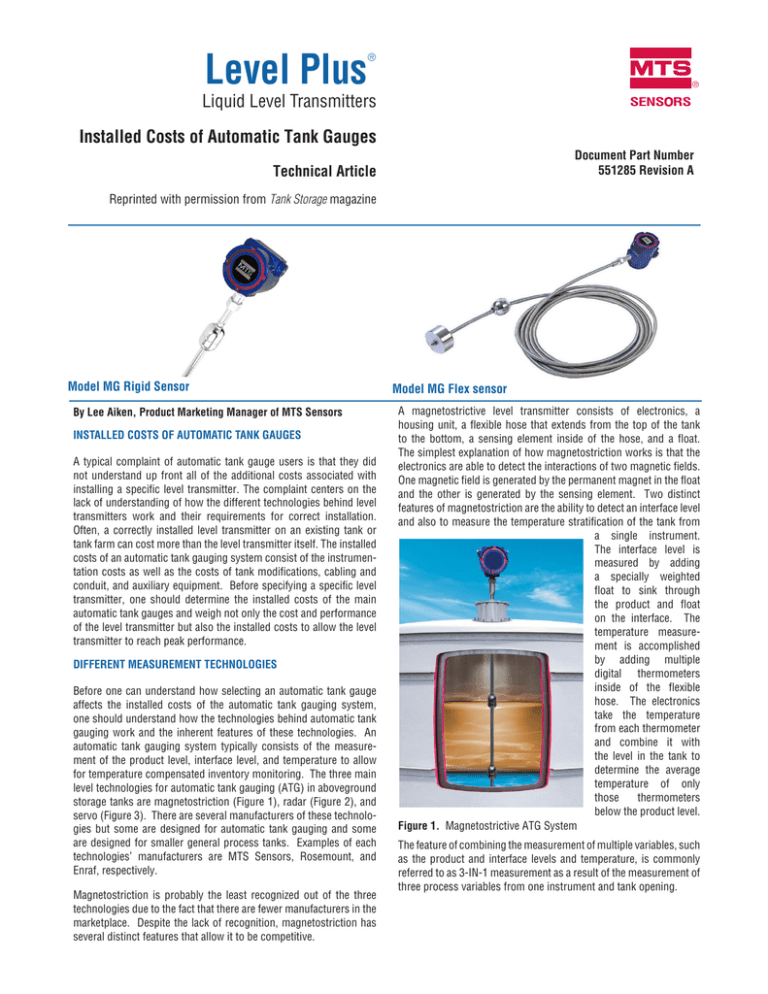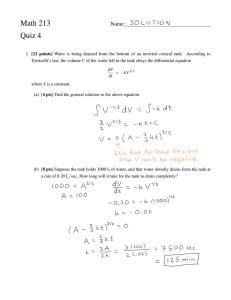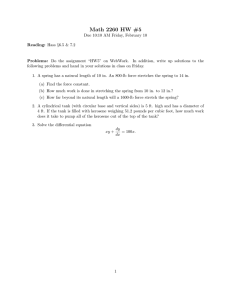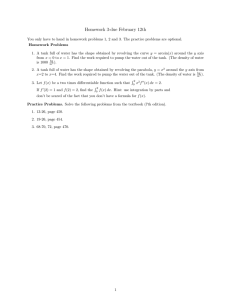
Level Plus
®
®
Liquid Level Transmitters
SENSORS
Installed Costs of Automatic Tank Gauges
Document Part Number
551285 Revision A
Technical Article
Reprinted with permission from Tank Storage magazine
Model MG Rigid Sensor
By Lee Aiken, Product Marketing Manager of MTS Sensors
INSTALLED COSTS OF AUTOMATIC TANK GAUGES
A typical complaint of automatic tank gauge users is that they did
not understand up front all of the additional costs associated with
installing a specific level transmitter. The complaint centers on the
lack of understanding of how the different technologies behind level
transmitters work and their requirements for correct installation.
Often, a correctly installed level transmitter on an existing tank or
tank farm can cost more than the level transmitter itself. The installed
costs of an automatic tank gauging system consist of the instrumentation costs as well as the costs of tank modifications, cabling and
conduit, and auxiliary equipment. Before specifying a specific level
transmitter, one should determine the installed costs of the main
automatic tank gauges and weigh not only the cost and performance
of the level transmitter but also the installed costs to allow the level
transmitter to reach peak performance.
DIFFERENT MEASUREMENT TECHNOLOGIES
Before one can understand how selecting an automatic tank gauge
affects the installed costs of the automatic tank gauging system,
one should understand how the technologies behind automatic tank
gauging work and the inherent features of these technologies. An
automatic tank gauging system typically consists of the measurement of the product level, interface level, and temperature to allow
for temperature compensated inventory monitoring. The three main
level technologies for automatic tank gauging (ATG) in aboveground
storage tanks are magnetostriction (Figure 1), radar (Figure 2), and
servo (Figure 3). There are several manufacturers of these technologies but some are designed for automatic tank gauging and some
are designed for smaller general process tanks. Examples of each
technologies’ manufacturers are MTS Sensors, Rosemount, and
Enraf, respectively.
Magnetostriction is probably the least recognized out of the three
technologies due to the fact that there are fewer manufacturers in the
marketplace. Despite the lack of recognition, magnetostriction has
several distinct features that allow it to be competitive.
Model MG Flex sensor
A magnetostrictive level transmitter consists of electronics, a
housing unit, a flexible hose that extends from the top of the tank
to the bottom, a sensing element inside of the hose, and a float.
The simplest explanation of how magnetostriction works is that the
electronics are able to detect the interactions of two magnetic fields.
One magnetic field is generated by the permanent magnet in the float
and the other is generated by the sensing element. Two distinct
features of magnetostriction are the ability to detect an interface level
and also to measure the temperature stratification of the tank from
a single instrument.
The interface level is
measured by adding
a specially weighted
float to sink through
the product and float
on the interface. The
temperature measurement is accomplished
by adding multiple
digital thermometers
inside of the flexible
hose. The electronics
take the temperature
from each thermometer
and combine it with
the level in the tank to
determine the average
temperature of only
those
thermometers
below the product level.
Figure 1. Magnetostrictive ATG System
The feature of combining the measurement of multiple variables, such
as the product and interface levels and temperature, is commonly
referred to as 3-IN-1 measurement as a result of the measurement of
three process variables from one instrument and tank opening.
DIFFERENT MEASUREMENT TECHNOLOGIES (Continued)
TANK MODIFICATION COSTS
In contrast to the lack of awareness of magnetostriction, radar is the
most widely known technology for automatic tank gauging. A radar
level transmitter determines the liquid level in the tank by taking a
time of flight measurement by sending a microwave signal and waiting for the return reflection from the liquid.
Radar is available as
either ‘through the air’
radar or guided wave
radar. The difference
between the two types
of radar is the ‘through
the air’ radar sends the
microwaves focused
by an antenna through
the air to determine
the liquid level whereas
the guided wave radar
sends the microwaves
through a pipe or metal
braid to help guide
the path of the microwaves.
Tank modification costs should also be considered when installing
an automatic tank gauge on an existing tank. Most existing tanks
are not designed to accommodate all of the necessary equipment
used for automatic tank gauging and thus need to be modified. The
mounting requirements
for the different level
technologies are dependent on the structure of
an existing tank and can
require no or several tank
modifications. Selecting
the level technology that
best fits the tank can save
thousands of dollars in
installed costs. The costs
of tank modifications can
be broken down into the
costs for tank openings
and the cost for stilling
wells. The costs of tank
modifications increase
with every additional
opening requirement
for the tank.
Figure 2. Servo ATG System
Figure 1. Radar ATG System
For large above ground storage tanks, the vast majority of technologies used is the ‘through the air’ radar and this technology will be
referred to from henceforth as radar. The radar level transmitter
is a non-contact level transmitter which has the advantage of not
being in contact with the product. This has allowed radar to develop
an installed base in applications with highly viscous liquids. The
disadvantage of non-contact level transmitters is that additional
process instruments are needed to measure the interface level and
temperature.
Additional openings are required when the automatic tank gauge
does not provide all of the necessary process variable measurements and for manual gauging/sampling. Magnetostriction level
transmitters do not require any additional tank openings due to the
3-IN-1 measurement capabilities. Radar level transmitters require
two additional tank openings for the interface measurement and
temperature measurement. Servo level transmitters require one additional tank opening for the temperature measurement. As a result,
magnetostrictive level transmitters have an inherent advantage due
to only requiring a single tank opening.
The third level technology is the servo level transmitter. The servo
level transmitter consists of a motor, spool, cable, weighted float,
and electronics. The liquid level is determined by raising and lowering the float via the spooled cable. The electronics of the servo level
transmitter measure the amount of cable that is being released while
monitoring for change in the tension of the cable. The tension of the
float on the cable will change as the float contacts and is immersed
in the liquid. Once the tension changes, the electronics determine
the tank level by subtracting the length of the cable from the tank
height. An interface level can also be determined by the servo
level transmitter through monitoring another change in tension.
The servo level transmitter can also be configured with the ability
to measure the density of the product in the tank. One drawback
to the interface and density level measurement is that these are not
continuous measurements and the measurements take between 30
to 60 minutes to perform. For applications that require interface and
density measurements, the measurements are often executed during an off-peak time, such as midnight. The servo level transmitter
requires an additional temperature instrument in order to achieve a
temperature measurement.
Level Plus® Liquid Level Transmitters - Technical Article
Installed Costs of Automatic Tank Gauges, Document Part No.: 551285, Revision A 08/11
The second part of tank modification is the requirement for stilling
wells. All three level technologies should be installed in a slotted
stilling well for the most accurate level measurement. However,
depending on the details of the application, some level technologies
can be installed without the need for a stilling well, allowing for
lower installed costs. In addition, stilling wells are typically required
to allow the additional interface and temperature measurement
instrumentation to perform correctly. The best course of action is to
consult the specific manufacturer about the details of the application
and if a stilling well is required for their automatic tank gauge. Once
all of the information is gathered, an informed decision can be made
about which level technology will have a lower installed cost.
2
MTS Sensors
CABLE AND CONDUIT
TOTAL INSTALLED COSTS
Cable and conduit choices are often mistakenly considered to be
the same for all level technologies and not included in the estimated
installed cost of automatic tank gauges. Cabling costs are composed
of the actual costs of the cable and the amount of cable needed. To
determine the costs of the cable simply access the installation manual
for the manufacturer’s cable specification. Some level transmitters
require separate power and communication cables or very specific
requirements. Even if the level transmitters are specified with the
same output protocol that does not equate to having the same cable
requirements or cost. A slight change in cable requirements can
cause a significant change in price.
Without understanding the impact of installed costs, projects often
run the risk of exceeding their budget. Tank modifications, cables
and conduits, and auxiliary equipment have been identified as key
areas where installed costs can be hidden. Studying these areas of
installed costs will help with determining which level technology best
suits an existing tank. In most situations that require fitting existing
tanks, magnetostrictive level transmitters have the lowest installed
cost followed by radar and lastly by servo. The main difference is the
ability of magnetostrictive level transmitters to measure the product
level, interface level, and temperature from a single tank opening.
When specifying a level transmitter for automatic tank gauging, talk
to the manufacturer to determine the installed costs of the automatic
tank gauge on a specific tank or tank farm and make an informed
decision on the installed costs of the system and not just the specifications of the level transmitter.
The wiring topology will also affect the overall cost of the cable and
conduit. For analog outputs, the wiring needs to be a direct connection between the level transmitter and the host system. For bus
networks, the wiring can share cabling and reduce the amount of
cable needed, although using the same bus network will not necessarily have the same topology requirements. Some level technologies
require individual power cables but will share the communication
cable. All of these differences should be examined and determined if
there are any significant cost differences in the level technologies.
AUXILIARY EQUIPMENT
Auxiliary equipment is the most overlooked installed cost of an automatic tank gauging system because the end user does not always
know it is needed and the costs can be lost in the quote. The best way
to determine the additional costs of auxiliary equipment is to have a
site survey performed and an official quote from the manufacturer
with line item detail. The manufacturer can go over the quote in detail
to explain what the equipment is used for and why it is necessary.
A few examples of auxiliary equipment are heaters for cold weather
applications, protocol converters for proprietary protocols, specialty
tools for service or installation, and licensed software. These are
just a few examples of auxiliary equipment that is not always clearly
defined as needed but increases the installed costs of the automatic
tank gauge system.
ABOUT MTS SENSORS:
MTS Sensors, a division of MTS Systems Corp., is the global leader in
the development and production of magnetostrictive linear-position
and liquid-level sensors.
MTS Sensors Division is continually developing new ways to apply
Temposonics® magnetostrictive sensing technology to solve critical
applications in a variety of markets worldwide. With facilities in the
U.S., Germany, Japan, and China, MTS Sensors Division is an ISO
9001-2008 certified supplier committed to providing customers with
innovative sensing products that deliver reliable position sensing
solutions.
Document Part Number: 551285, Revision A 08/11
MTS, Temposonics and Level Plus are registered trademarks of MTS Systems Corporation.
All other trademarks are the property of their respective owners. Printed in USA.
Copyright © 2011 MTS Systems Corporation. All rights reserved in all media.
®
SENSORS
MTS Systems Corporation
Sensors Division
MTS Sensor Technologie
GmbH & Co. KG
MTS Sensors Technology
Corporation
3001 Sheldon Drive
Cary, North Carolina
27513, USA
Tel.:+1-800-633-7609
Fax:+1-919-677-2343
+1-800-498-4442
e-mail: sensorsinfo@mts.com
http://www.mtssensors.com
Auf dem Schüffel 9
D - 58513 Lüdenscheid, Germany
Tel.:+49-2351-9587-0
Fax:+49-2351-56491
e-mail: info@mtssensor.de
http://www.mtssensor.de
737 Aihara-cho, Machida-shi
Tokyo 194-0211, Japan
Tel.:+81-42-775-3838
Fax:+81-42-775-5516
e-mail: info@mtssensor.co.jp
http://www.mtssensor.co.jp





